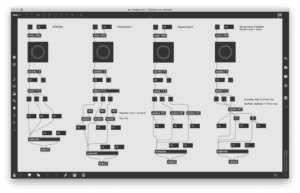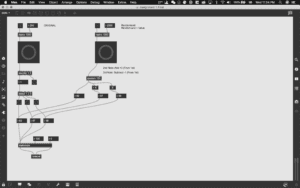Initial Attempt: (Far Right Side/Not Final)

CODE: NOT NEEDED/GIVEN
For this first assignment, I went in head straight with only the information provided during class, my memory and research skills. I duplicated the original code onto a new patcher and began to work. With my knowledge from previous IMA courses, I understood that in order to complete the task, I would need to use some sort of randomizing text/code. I was not sure how to achieve this on Max, and therefore, went online to search for any kind of material that could help me progress through the assignment. I was able to find this website: https://docs.cycling74.com/max7/refpages/random, through the page, I was able to understand the “Random Object.” How it functions, how I should set it up, how its inputs and outputs work, how it should be connected to other components and so on. I attached the random message to the ends of each of my three buttons. I’ve learned that the number that follows the command, is the value that sets the range for the output. I realized that whatever value I place, the range would be equal to one less of the number. To ensure that the range would be contained through 0 – 100, I wrote “Random 101“ and then connected three separate number boxes to the random’s output section to display the numerical values throughout the process. Afterward, I reattached the whole piece to the makenote/noteout. This was the final product I was able to achieve with my own understanding and representation of the instructions provided for the assignment. In the end, I scrapped this design of the assignment due to a misunderstanding of the instructions on my part. I got to work on the second and final completion of the assignment in the next section with help from my professor.
Final Attempt:

CODE: https://gist.github.com/cy1323/265ec3f03e55b4a0a527b8061245e6c1
I finally understood the prompt when I asked for clarification during Tuesday’s class. I learned that I am supposed to have two separate sections by building off of the original patcher provided during the class and sending a new set of values to the original every two seconds. I continued usage of the randomizer command as well as the +/- values in order to relate the three values to one another. I did not change much for this final attempt. Rather than adding new components, I deleted the unnecessary sections and connected the two patchers together. With help during class, I learned that I needed to connect the second patcher to the first’s number (i) inputs. This would allow the second patcher to transfer its given sets after each two second bang to the main section that outputs music.
Video: FinalVideo